Authentication of a Stradivarius “Petite Violin” Type from 1723
Abstract
1. Introduction
- -
- Reducing the thickness of the resonance box.
- -
- The symmetry and positioning of the f-holes relative to the support bar on the inside and relative to the mouthpiece.
- -
- The gradual thinning of the covers on the inside, from the middle to the stirrups for acoustics.
- -
- Hydrothermal treatment in borax and alum solution of the wood of the two caps, after cutting from dry radial tops in unbarked log for seven years (in open strips) and mechanical processing, as close as possible to the final shape.
- -
- Closing the lids for resonance testing, followed by further finishing of both lids on the inside and outside with final closing.
- -
- The wood used for the upper cover being spruce or white fir (rarely pine), aged over 100 years (annual rings between 0.5 and maximum 2 mm) and without anatomical defects (twists, stumps, etc.); and the wood for the lower cover being is alder, maple and other essence with above average hardness.
- -
- Varnishing performed with an alcoholic solution of rosin or other transparent vegetable resins, mixed with beeswax and propolis, in a small concentration, after a very fine finish; smoothing performed with a thin transparent layer of gypsum, with an egg-based binder [2].
2. Materials and Methods
2.1. Optical Microscopy
2.2. SEM–EDX
2.3. µ-FTIR Analysis
2.4. Thermal Analysis
3. Results and Discussions
3.1. History of the Violin
3.2. Dimensions and Identification of Model 1723, “Petite Violin”
3.3. Conservation Status
3.4. Microscopic Analysis
3.5. SEM–EDX Analysis
3.6. Micro-FTIR Analysis
3.7. Thermal Analysis
3.8. Age Assessment of Violin
- -
- -
- the depth of the presence of the archaeometric characteristics (the gradient of the penetration of oxidatively encrusted dirt in the volume phase of the varnish, the crystallinity index of the cellulose, its degree of lateral ordering and the intensity of the hydrogen bonds, and, thus, the remaining concentration of the ash of the wood sample) and the chemometric ones with archaeometric value (elemental stoichiometry ratios: C/O for wood, C/S and C/O for varnish and Si/Al for the encrusted dirt on the varnish) [54];
- -
- the morphology of the surfaces, highlighting the iridescence, texture and microtopographical structures [55];
- -
4. Conclusions
Author Contributions
Funding
Acknowledgments
Conflicts of Interest
References
- Sandu, I.; Tanasa, P.O.; Sandu, I.C.A.; Negru, I.C.; Sandu, A.V.; Vasilache, V. Authentication of an Old Violin by Multianalytical Methods. App. Sci. 2020, 10, 306. [Google Scholar] [CrossRef]
- Stani, C.; Invernizzi, C.; Briarda, G.; Davit, P.; Vaccari, L.; Magalodi, M.; Gulmini, M.; Fiocco, G. A Nanofocused Light on Stradivari Violins: Infrared s-SNOM Reveals New Clues Behind Craftsmanship Mastery. Anal. Chem. 2022, 94, 14815–14819. [Google Scholar] [CrossRef] [PubMed]
- Malagodi, M.; Canevari, C.; Bonizzoni, L.; Galli, A.; Maspero, F.; Martini, M. A multi-technique chemical characterization of a Stradivari decorated violin top plate. Appl. Phys. A 2013, 112, 225–234. [Google Scholar] [CrossRef]
- Cortea, I.M.; Cristache, R.A.; Sandu, I. Characterization of historical violin varnishes using ATR-FTIR spectroscopy. Rom. Rep. Phys. 2016, 68, 615–622. [Google Scholar]
- Cristache, R.A. Study of New Archaeometric Characteristics of Old Wood Artefacts. Ph.D. Thesis, Alexandru Ioan Cuza University, Faculty of Geography and Geology, Iasi, Romania, 2015. [Google Scholar]
- Brandmair, B.; Greiner, S.P. Stradivari Varnish: Scientific Analysis of His Finishing Technique on Selected Instruments; Serving Audio: London, UK; Munich, Germany, 2010. [Google Scholar]
- Daher, C.; Paris, C.; Le Hô, A.S.; Bellot-Gurlet, L.; Echard, J.P. A joint use of Raman and infrared spectroscopies for the identification of natural organic media used in ancient varnishes. J. Raman Spectrosc. 2010, 41, 1494–1499. [Google Scholar] [CrossRef]
- Sacconi, S.F. The “Secrets” of Stradivari; Libreria del Convegno: Cremona, Italy, 1979. [Google Scholar]
- Weththimuni, M.L.; Canevari, C.; Legnani, A.; Licchelli, M.; Malagodi, M.; Ricca, M.; Zeffiro, A. Experimental characterization of oil-colophony varnishes: A preliminary study. Int. J. Conserv. Sci. 2016, 7, 813–826. [Google Scholar]
- The “Stradivarius” Violin Label: What It Means. Available online: https://www.benningviolins.com/the-stradivarius-violin-label-what-it-means.html (accessed on 3 January 2023).
- Mukhopadhyay, R. How Stradivari and Guarneri got their music violins. Anal. Chem. 2009, 79, 819–820. [Google Scholar] [CrossRef]
- Bertrand, L.; Robinet, L.; Cohen, S.X.; Sandt, C.; Le Hô, A.-S.; Soulier, B.; Lattuati-Derieux, A.; Echar, J.P. Identification of the finishing technique of an early eighteenth century musical instrument using FTIR spectromicroscopy. Anal. Bioanal. Chem. 2011, 399, 3025–3032. [Google Scholar] [CrossRef]
- Chen, G.F. Developments in the field of rosin chemistry and its implications in coatings. Prog. Org. Coat. 1992, 20, 139–167. [Google Scholar] [CrossRef]
- Echard, J.P.; Benoit, C.; Peris-Vicente, J.; Malecki, V.; Gimeno-Adelantado, J.V.; Vaiedelich, S. Gas chromatography/mass spectrometry characterization of historical varnishes of ancient Italian lutes and violin. Anal. Chim. Acta 2007, 584, 172–180. [Google Scholar] [CrossRef]
- Echard, J.P.; Bertrand, L.; von Bohlen, A.; le Hô, A.-S.; Paris, C.; Bellot-Gurlet, L.; Soulier, B.; Lattuati-Derieux, A.; Thao, S.; Robinet, L.; et al. The nature of the extraordinary finish of Stradivari’s instruments. Angew. Chem. Int. Ed. 2010, 49, 197–201. [Google Scholar] [CrossRef]
- Fioravanti, M.; Goli, G.; Carlson, B. Viscoelastic and mechano-sorptive studies appliaed to the conservation of historical violins: A case study of the Guarneri “del Gesù” violin (1743) known as the “Cannone”. J. Cult. Herit. 2013, 14, 297–303. [Google Scholar] [CrossRef]
- Noguera, J.R.; Galiano, F.C.B.; Lòpez, J.M.R.; Vivas, M.A.F.; Sànchez, I.M. Study of biodegradation of diterpenic varnishes used in art painting: Colophony and Venetian turpentine. Int. Biodeterior. Biodegrad. 2008, 62, 427–433. [Google Scholar] [CrossRef]
- Sandu, I.; van Saanen, A. Expertiza Ştiinţifică a Operelor de artă, Vol. I, Autentificarea, Stabilirea Paternităţii şi Evaluarea Patrimonială; Editura Universităţii “Alexandru Ioan Cuza”: Iași, Romania, 1998. [Google Scholar]
- Sandu, I.; Sandu, I.G. Aspecte Moderne Privind Conservarea Bunurilor Culturale, Vol.I. Nomenclatură, Tipologii şi Cazuistici; Editura Performantica: Iași, Romania, 2005. [Google Scholar]
- Scalarone, D.; Lazzari, M.; Chiantore, O. Ageing behaviour and pyrolytic characterization of diterpenic resins used as art materials: Colophony and Venice turpentine. J. Anal. Appl. Pyrolysis 2002, 64, 345–361. [Google Scholar] [CrossRef]
- Caruso, F.; Chillura Martino, D.F.; Saverwyns, S.; Van Bos, M.; Burgio, L.; Di Stefano, C.; Peschke, G.; Caponetti, E. Micro-analytical identification of the components of varnishes from South Italian historical musical instruments by PLM, ESEM–EDX, microFTIR, GC–MS, and Py–GC–MS. Microchem. J. 2014, 116, 31–40. [Google Scholar] [CrossRef]
- Echard, J.P.; Lavedrine, B. Review on the characterisation of ancient stringed musical instruments varnishes and implementation of an analytical strategy. J. Cult. Herit. 2008, 9, 420–429. [Google Scholar] [CrossRef]
- Fierascu, I.; Fierascu, R.C.; Stirban, A.; Panaitescu, D.M.; Nicolae, C.A.; Raditoiu, V.; Zgarciu, M.S.; Leahu, A.C. Chemical and mineral characterisation of Roumanian book paper materials (XVII-XIXth century). Microchem. J. 2020, 152, 104307. [Google Scholar] [CrossRef]
- Frohlich, B.; Sturm, G.; Hinton, J.; Frohlich, E. The Secrets of The Stradivari String Instruments. A Non Destructive Study of Music Instruments from The Smithsonian Institution, The Library of Congress, and Private Collections. A Pilot Study of Seven Violins Made by Antonio Stradivari in Cremona, Italy, Between 1677 and 1709; The Materialise Group: Leuven, Belgium; Materialise USA: Ann Arbor, MI, USA; Washington, DC, USA, 2009. [Google Scholar]
- Su, C.; Chen, S.-Y.; Chung, J.-H.; Li, G.-C.; Brandmair, B.; Huthwelker, T.; Fulton, J.L.; Borca, C.; Huang, S.-J.; Nagyvary, J.; et al. Materials Engineering of Violin Soundboards by Stradivari and Guarneri. Angw. Chem. 2021, 133, 19293–19303. [Google Scholar] [CrossRef]
- Bellamy, L.J.; Gerrard, W.; Lappert, M.F.; Williams, R.L. Infrared spectra of boron compounds. J. Chem. Soci. 1958, 481, 2412–2415. [Google Scholar] [CrossRef]
- Jun, L.; Shuping, X.; Shiyang, G. FT-IR and Raman spectroscopic study of hydrated borates. Spectrochim. Acta Part A Mol. Biomol. Spectrosc. 1995, 51, 519–532. [Google Scholar] [CrossRef]
- Weir, C.E. Infrared spectra of the hydrated borates. J. Res. Natl. Bur. Stand. A Phys. Chem. 1966, 70, 153–164. [Google Scholar] [CrossRef]
- Caldeira, F. Boron in wood preservation. A review in its physico-chemical aspects. Silva Lusit. 2010, 18, 179–196. [Google Scholar]
- Schwanninger, M.; Rodrigues, J.C.; Pereira, H.; Hinterstoisser, B. Effects of short-time vibratory ball milling on the shape of FT-IR spectra of wood and cellulose. Vib. Spectrosc. 2004, 36, 23–40. [Google Scholar] [CrossRef]
- Fackler, K.; Stevanic, J.S.; Ters, T.; Hinterstoisser, B.; Schwanninger, M.; Salmén, L. Localisation and characterisation of incipient brown-rot decay within spruce wood cell walls using FT-IR imaging microscopy. Enzym. Microb. Technol. 2010, 47, 257–267. [Google Scholar] [CrossRef] [PubMed]
- Simonović, J.; Stevanic, J.; Djikanović, D.; Salmén, L.; Radotić, K. Anisotropy of cell wall polymers in branches of hardwood and softwood: A polarized FTIR study. Cellulose 2011, 18, 1433–1440. [Google Scholar] [CrossRef]
- Munajad, A.; Subroto, C.; Suwarno. Fourier Transform Infrared (FTIR) Spectroscopy Analysis of Transformer Paper in Mineral Oil-Paper Composite Insulation under Accelerated Thermal Aging. Energies 2018, 11, 364. [Google Scholar] [CrossRef]
- Ciofini, D.; Osticioli, I.; Micheli, S.; Montalbano, L.; Siano, S. Laser removal of mold and foxings stains from paper artifacts: Preliminary investigation. In Fundamentals of Laser-Assisted Micro- and Nanotechnologies 2013; SPIE: Bellingham, WA, USA, 2013; Volume 9065, p. 906512. [Google Scholar] [CrossRef]
- Calvini, P.; Gorassini, A. The Degrading Action of Iron and Copper on Paper A FTIR-Deconvolution Analysis. Restaur. Int. J. Preserv. Libr. Arch. Mater. 2002, 23, 205–221. [Google Scholar] [CrossRef]
- Librando, V.; Minniti, Z.; Lorusso, S. Ancient and modern paper characterization by FTIR and Micro-Raman spectroscopy. Conserv. Sci. Cult. 2011, 11, 249–268. [Google Scholar] [CrossRef]
- Chiriu, D.; Ricci, P.C.; Cappellini, G.; Salis, M.; Loddo, G.; Carbonaro, C.M. Ageing of ancient paper: A kinetic model of cellulosedegradation from Raman spectra. J. Raman Spectrosc. 2018, 49, 1802–1811. [Google Scholar] [CrossRef]
- Baccaro, S.; Carewska, M.; Casieri, C.; Cemmi, A.; Lepore, A. Structure modifications and interaction with moisture in γ-irradiated pure cellulose by thermal analysis and infrared spectroscopy. Polym. Degrad. Stab. 2013, 98, 2005–2010. [Google Scholar] [CrossRef]
- Poletto, M.; Ornaghi Júnior, H.L.; Zattera, A.J. Native cellulose: Structure, characterization andthermal properties. Materials 2014, 7, 6105. [Google Scholar] [CrossRef] [PubMed]
- Măluțan, T.; Oborcea, P.P.; Pui, A. IR spectroscopy of the pulps obtained by kraft additivated delignification. Rev. Celul. Hârtie 2002, 51, 17–20. [Google Scholar]
- Chang, S.T.; Chang, H.T.; Huang, Y.S.; Hsu, F.L. Effects of chemical modification reagents on acoustic properties of wood. Holzforschung 2000, 54, 669–675. [Google Scholar] [CrossRef]
- Ahmed, S.A.; Adamopoulos, S. Acoustic properties of modified wood under different humid conditions and their relevance for musical instruments. Appl. Acoust. 2018, 140, 92–99. [Google Scholar] [CrossRef]
- Tanasa, P.O.; Sandu, I.; Vasilache, V.; Sandu, I.G.; Negru, I.C.; Sandu, A.V. Authentication of a Painting by Nicolae Grigorescu Using Modern Multi-Analytical Methods. Appl. Sci. 2020, 10, 3558. [Google Scholar] [CrossRef]
- Tănasă, P.O. Modern Methods of Authenticating Criminal Assets, Conservation Procedures during the Investigation, Saving and Reintroducing Them into the Circuit of Cultural Heritage Values. Ph.D. Thesis, Faculty of Geography and Geology, “Alexandru Ioan Cuza” University of Iași, Iași, Romania, 2022. [Google Scholar]
- Vasilache, V.; Sandu, I.C.A.; Pruteanu, S.; Caldeira, A.T.; Simionescu, A.E.; Sandu, I. Testing the Cleaning Effectiveness of New Ecological Aqueous Dispersions Applied on Old Icons. Appl. Surf. Sci. 2016, 367, 70–79. [Google Scholar] [CrossRef]
- Pruteanu, S.; Sandu, I.; Vasilache, V. Modern Procedures Used in Cleaning Old, Illegibly and Blackened Icons. Environ. Dev. Sustain. 2013, 9, 219–236. [Google Scholar] [CrossRef]
- Pruteanu, S.; Vasilache, V.; Sandu, I.C.A.; Budu, A.M.; Sandu, I. Assessment of Cleaning Effectiveness for New Ecological Systems on Ancient Tempera Icon by Complementary Microscopy Techniques. Microsc. Res. Tech. 2014, 77, 1060–1070. [Google Scholar] [CrossRef]
- Iurcovschi, T.C.; Vasilache, V.; Sandu, I.; Zaharia, M.; Pintilie, O.; Sandu, A.V. New Ecological Solutions Involved in the Cleaning of a 19th Century Icon. Appl. Sci. 2020, 10, 1175. [Google Scholar] [CrossRef]
- Rovetta, T.; Invernizzi, C.; Fiocco, G.; Albano, M.; Licchelli, M.; Gulmini, M.; Alf, G.; Fabbri, D.; Rombolà, A.G.; Malagodi, M. The case of Antonio Stradivari 1718 ex-San Lorenzo violin: History, restorations and conservation perspectives. J. Archaeol. Sci. Rep. 2019, 23, 443–450. [Google Scholar] [CrossRef]
- Bonizzoni, L.; Canevari, C.; Galli, A.; Gargano, M.; Ludwig, N.; Malagodi, M.; Rovetta, T. A multidisciplinary materials characterization of a Joannes Marcus viol (16th century). Herit. Sci. 2014, 2, 15. [Google Scholar] [CrossRef]
- Fichera, G.V.; Rovetta, T.; Fiocco, G.; Alberti, G.; Invernizzi, C.; Licchelli, M.; Malagodi, M. Elemental analysis as statistical preliminary study of historical musical instruments. Microchem. J. 2018, 137, 309–317. [Google Scholar] [CrossRef]
- Lattuati-Derieux, A.; Gomes, S.; Tirat, S.; Thao-Hey, S.; Echard, J.-P. New insights into molecular evolution of oil/colophony varnishes, towards pyrolysis-gas chromatography/mass spectrometry based quantitation. E-Preserv. Sci. 2014, 11, 53–63. [Google Scholar]
- Odlyha, M.; Lucejko, J.J.; Lluveras-Tenorio, A.; di Girolamo, F.; Hudziak, S.; Strange, A.; Bridarolli, A.; Bozec, L.; Colombini, M.P. Violin Varnishes: Microstructure and Nanomechanical Analysis. Molecules 2022, 27, 6378. [Google Scholar] [CrossRef]
- Azemard, C.; Vieillescazes, C.; Menager, M. Effect of photodegradation on the identification of natural varnishes by FT-IR spectroscopy. Microchem. J. 2014, 112, 137–149. [Google Scholar] [CrossRef]
- Beltran, V.; Salvadó, N.; Butí, S.; Cinque, G. Micro infrared spectroscopy discrimination capability of compounds in complex matrices of thin layers in real sample coatings from artworks. Microchem. J. 2015, 118, 115–123. [Google Scholar] [CrossRef]
- Tai, H.-C.; Li, G.-C.; Huang, S.-J.; Jhu, C.-R.; Chung, J.-H.; Wang, B.Y.; Hsu, C.-S.; Brandmair, B.; Chung, D.-T.; Chen, H.M.; et al. Chemical distinctions between Stradivari’s maple and modern tonewood. Proc. Natl. Acad. Sci. USA 2016, 114, 27–32. [Google Scholar] [CrossRef]
- Lämmlein, S.L.; Mannes, D.; van Damme, B.; Schwarze, F.W.M.R.; Burgert, I. The influence of multi-layered varnishes on moisture protection and vibrational properties of violin wood. Sci. Rep. 2019, 9, 18611. [Google Scholar] [CrossRef]
- Albano, M.; Comelli, D.; Fiocco, G.; Mattonai, M.; Lucejko, J.J.; Zoia, L.; Colombini, M.P.; Malagodi, M. Chemical modification of wood induced by the traditional making procedures of bowed string musical instruments: The effect of alkaline treatments. Herit. Sci. 2022, 10, 76. [Google Scholar] [CrossRef]
- Hinterstoisser, B.; Salmén, L. Two-dimensional step-scan FTIR: A tool to unravel the OH-valency-range of the spectrum of Cellulose I. Cellulose 1999, 6, 251–263. [Google Scholar] [CrossRef]
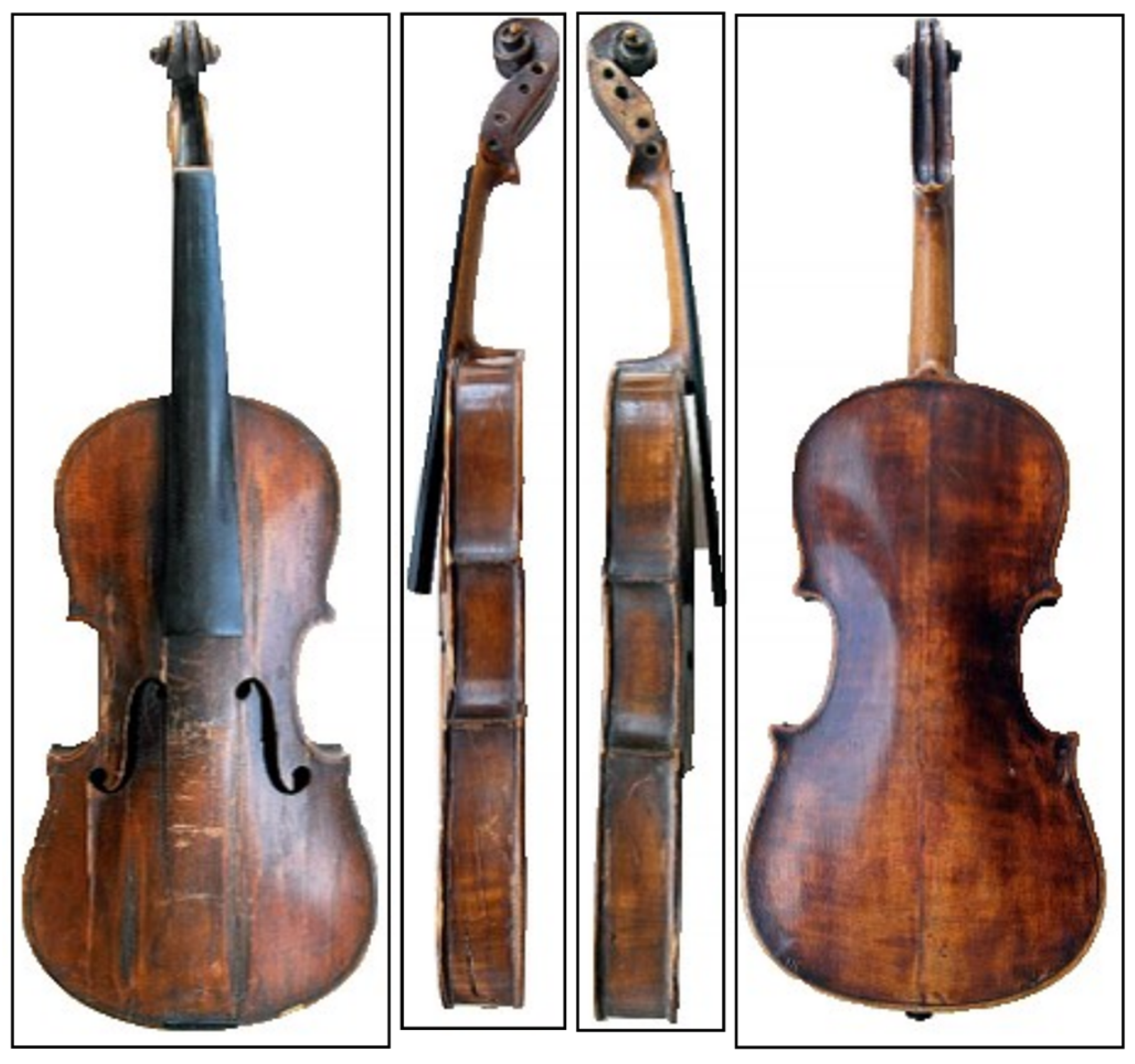

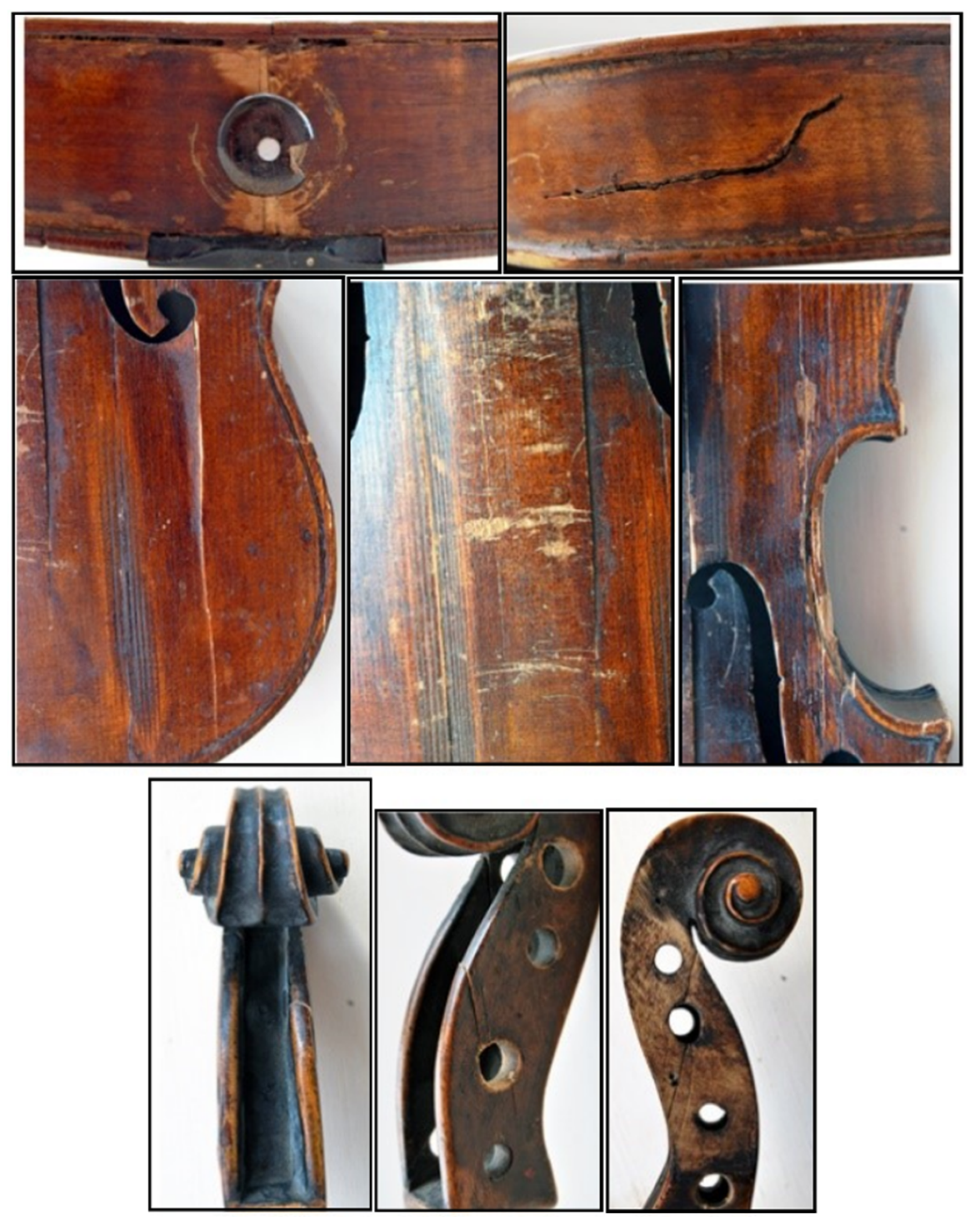
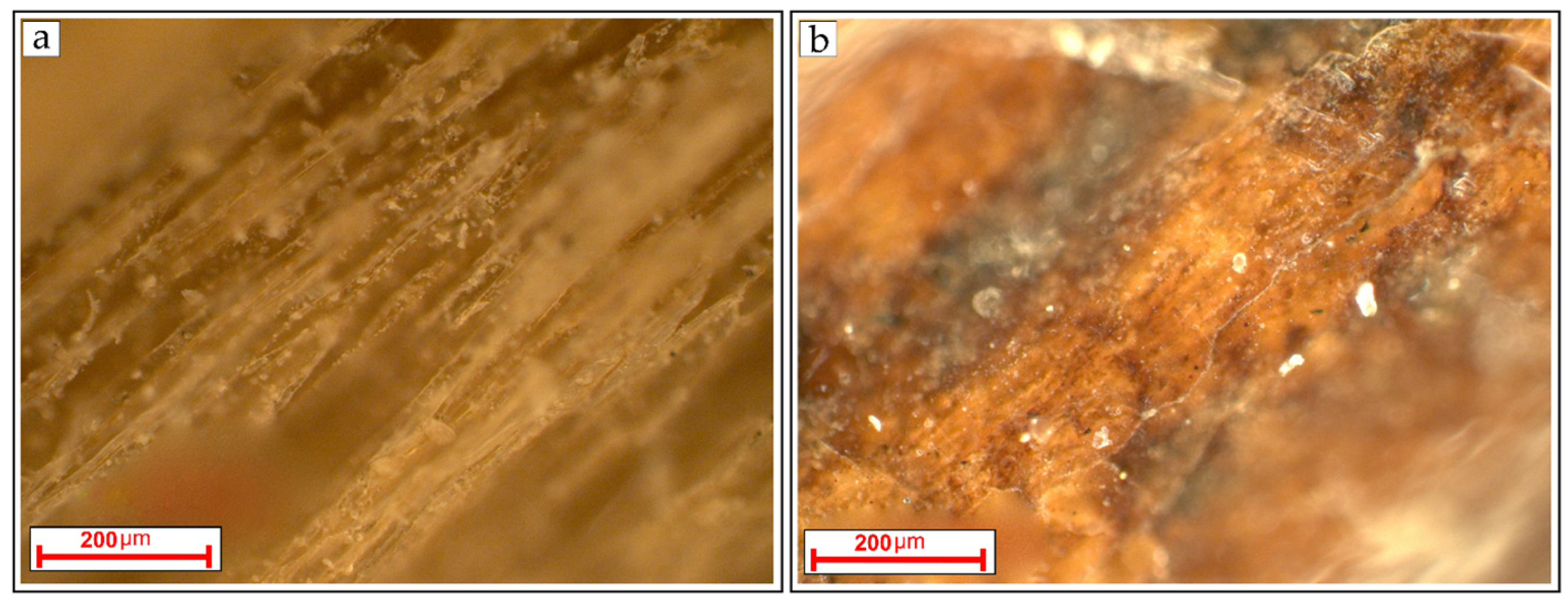
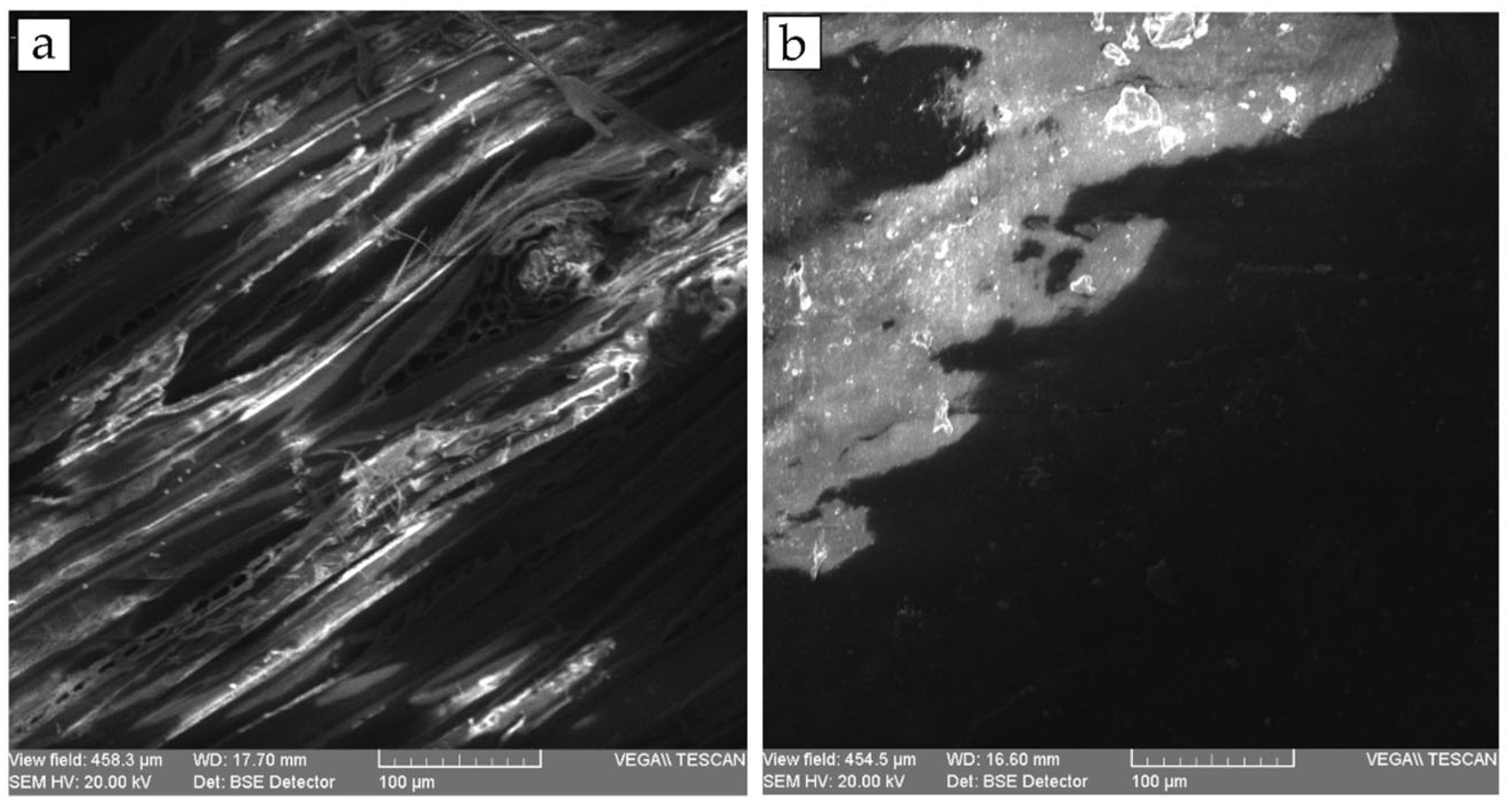

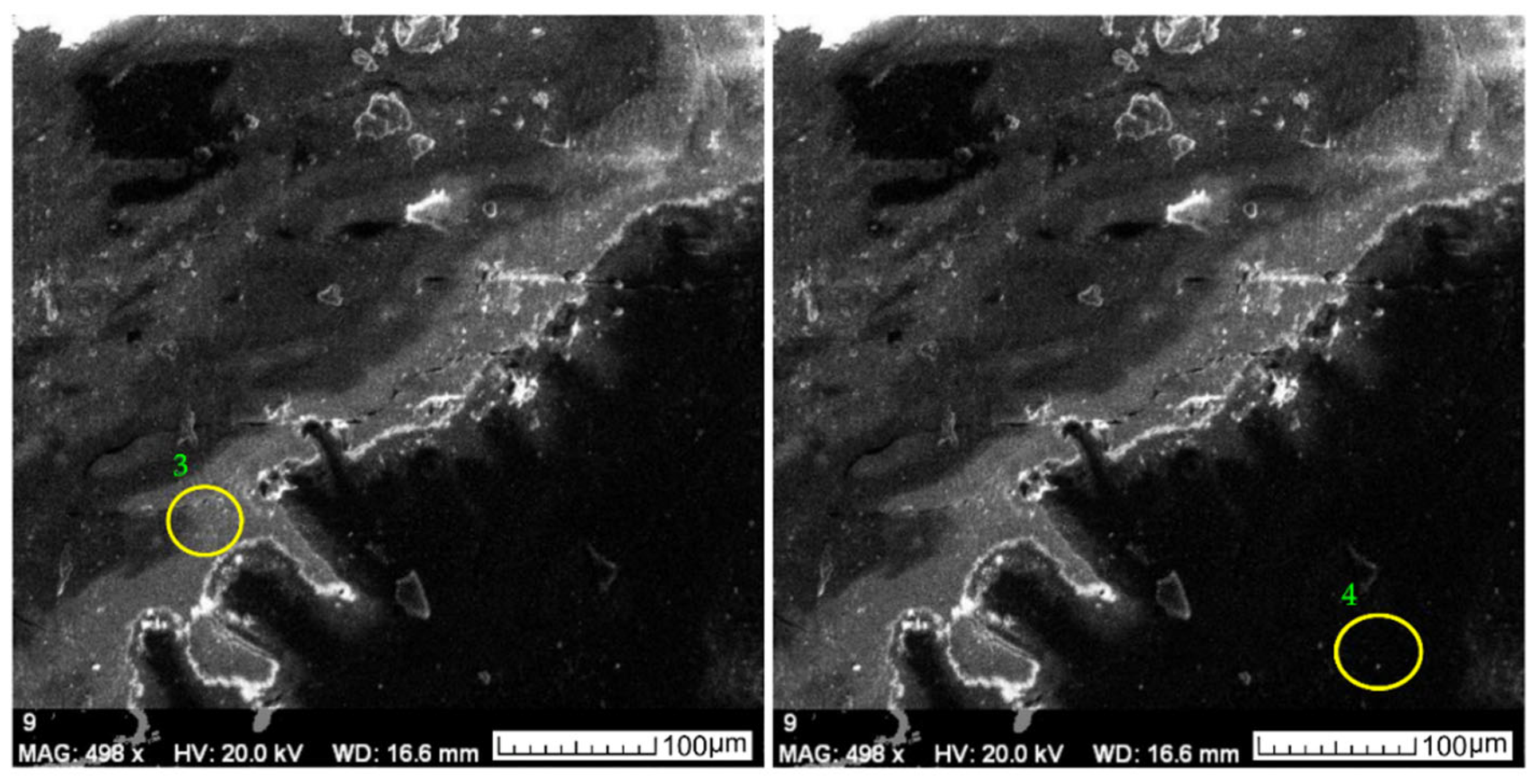
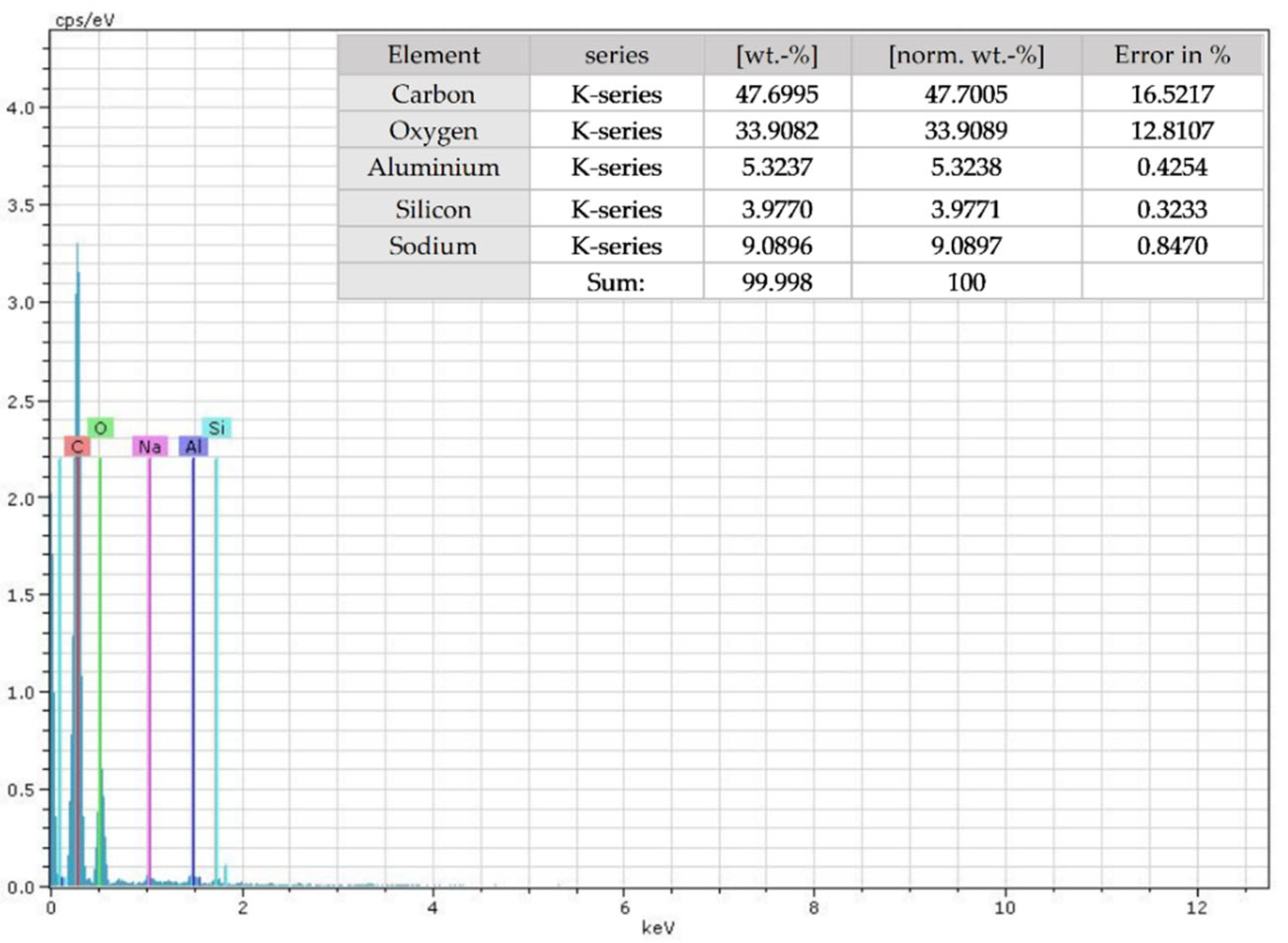
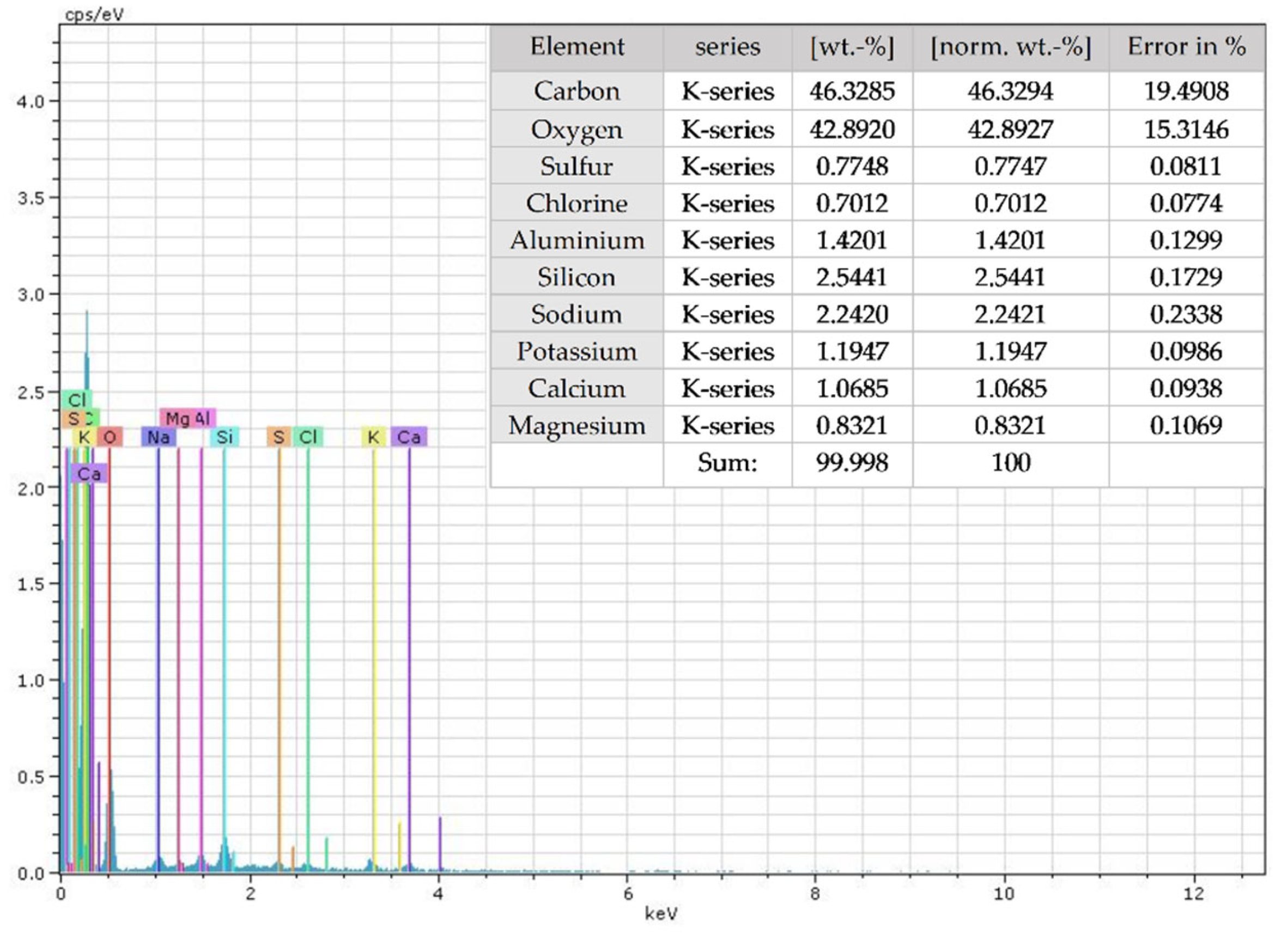

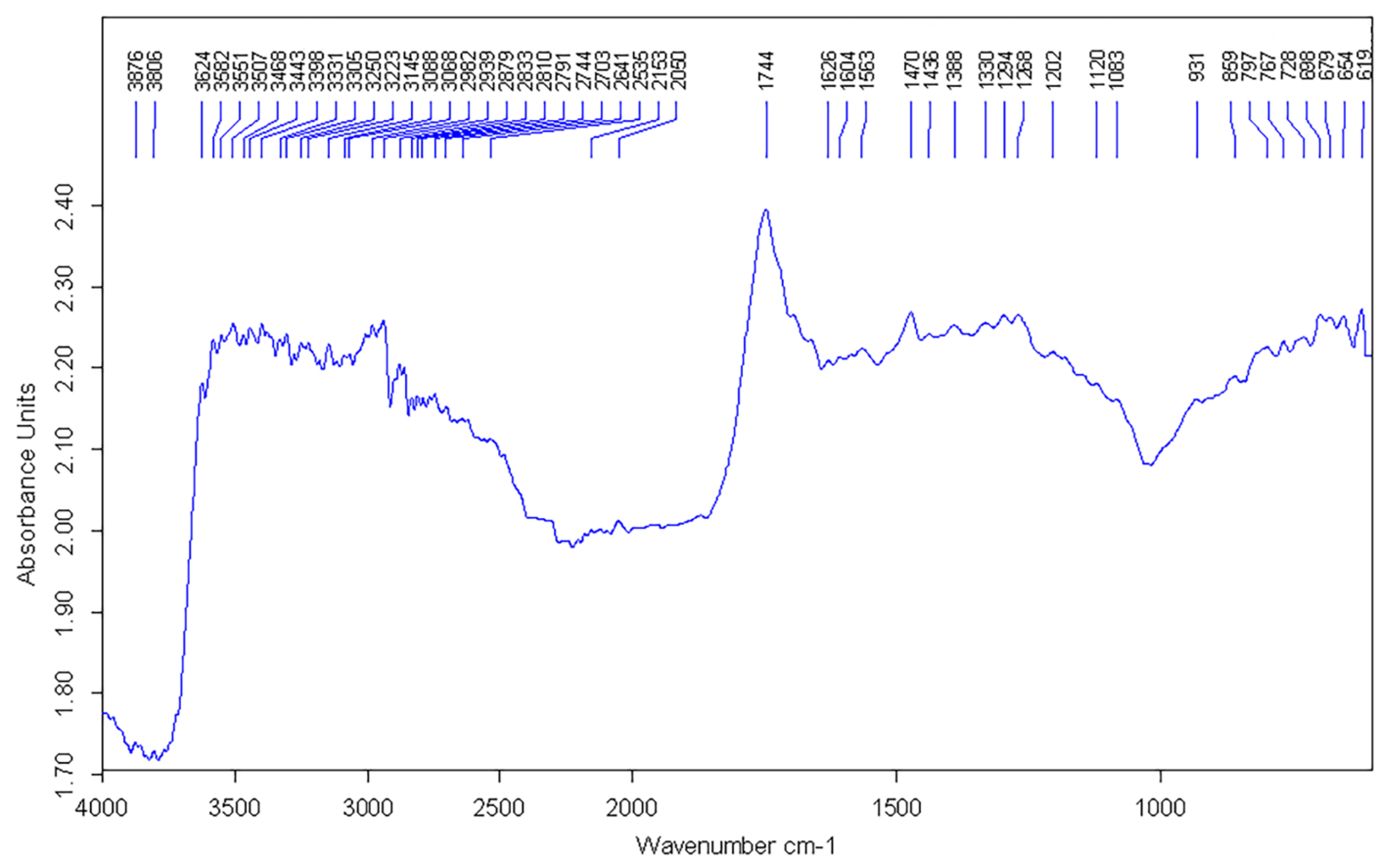
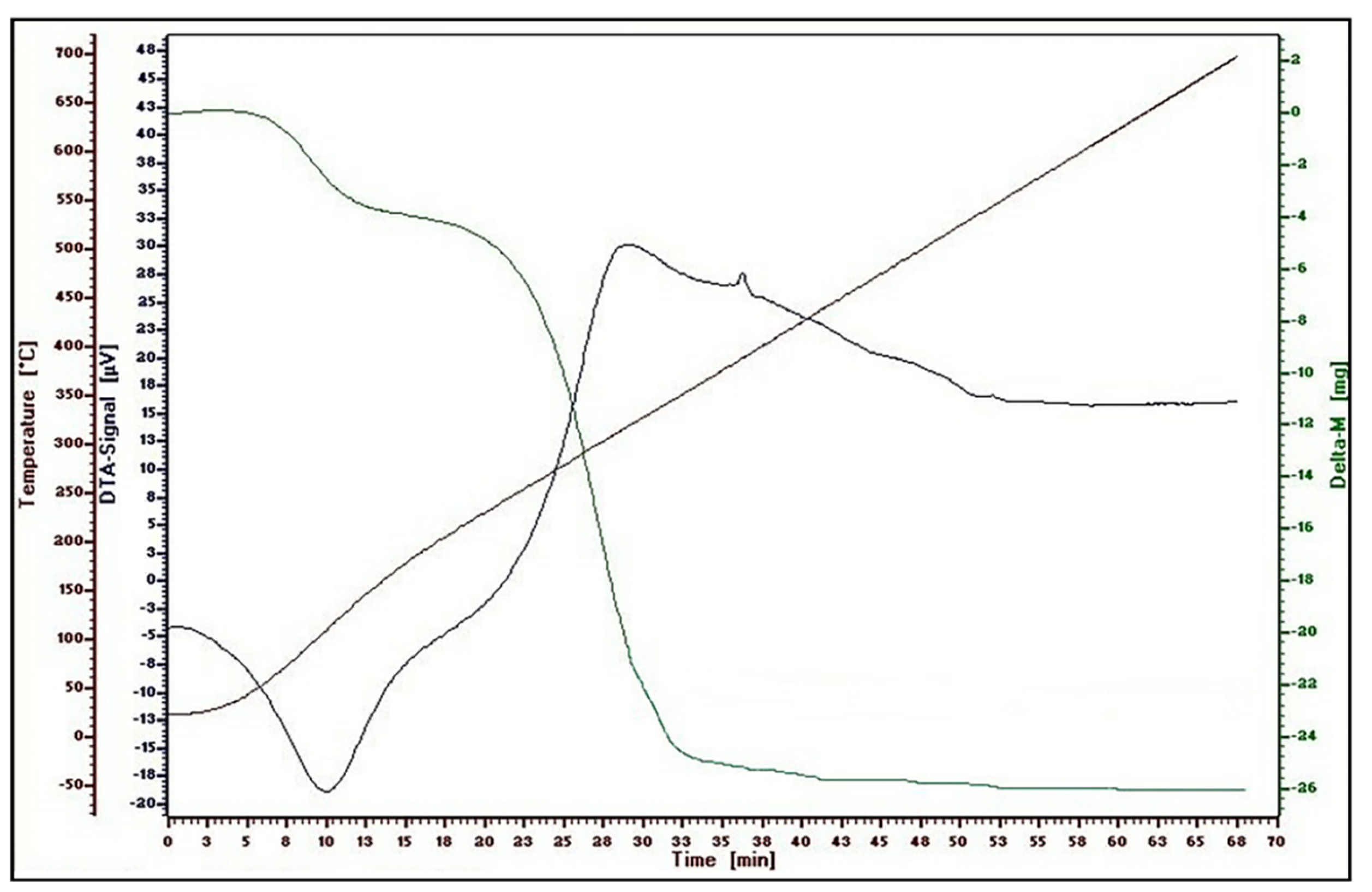
| Crystallinity Index (Ic) | Degree of Lateral Ordering (GOL) | Intensity of Hydrogen Bonds (IlegH) |
|---|---|---|
| A1377/A2906 = 1.17 | A1431/A896 = 1.12 | A3420/A1318 = 0.94 |
| Characteristic | Actual Value | Reference Value | Evolution Rate (/year) | |
|---|---|---|---|---|
| Archaeometric | The penetration gradient of the oxidatively fouled dirt in the volume phase of the varnish (μm) | 0.6–2.5 | 0.0–0.0 | ~5 × 10−3 |
| Cellulose crystallinity index | 1.17 | 1.384 | ~7 × 10−4 | |
| Degree of lateral ordering | 1.12 | 1.184 | ~2 × 10−4 | |
| The intensity of hydrogen bonds | 0.94 | 1.063 | ~4 × 10−4 | |
| Ash concentration (%) | 1.21 | 0.58 | ~2 × 10−3 | |
| Chemometric | C/O for wood | 0.713 | 0.801 | ~3 × 10−4 |
| Al/K for wooden alum | 0.750 | 0.692 | ~2 × 10−4 | |
| C/S for the preparation under the varnish | 47.00 | 51.00 | ~1.3 × 10−2 | |
| C/O for varnish | 1.08 | 0.650 | ~1.4 × 10−3 | |
| Al/Si from the dirt layer on the varnish | 0.5582 | 0.00 | ~1.9 × 10−3 | |
Disclaimer/Publisher’s Note: The statements, opinions and data contained in all publications are solely those of the individual author(s) and contributor(s) and not of MDPI and/or the editor(s). MDPI and/or the editor(s) disclaim responsibility for any injury to people or property resulting from any ideas, methods, instructions or products referred to in the content. |
© 2023 by the authors. Licensee MDPI, Basel, Switzerland. This article is an open access article distributed under the terms and conditions of the Creative Commons Attribution (CC BY) license (https://creativecommons.org/licenses/by/4.0/).
Share and Cite
Sandu, I.; Tănasă, P.O.; Brînză, F.; Vasilache, V.; Drob, A.; Drobotă, V. Authentication of a Stradivarius “Petite Violin” Type from 1723. Appl. Sci. 2023, 13, 1048. https://doi.org/10.3390/app13021048
Sandu I, Tănasă PO, Brînză F, Vasilache V, Drob A, Drobotă V. Authentication of a Stradivarius “Petite Violin” Type from 1723. Applied Sciences. 2023; 13(2):1048. https://doi.org/10.3390/app13021048
Chicago/Turabian StyleSandu, Ion, Petru Ovidiu Tănasă, Florin Brînză, Viorica Vasilache, Ana Drob, and Vasile Drobotă. 2023. "Authentication of a Stradivarius “Petite Violin” Type from 1723" Applied Sciences 13, no. 2: 1048. https://doi.org/10.3390/app13021048
APA StyleSandu, I., Tănasă, P. O., Brînză, F., Vasilache, V., Drob, A., & Drobotă, V. (2023). Authentication of a Stradivarius “Petite Violin” Type from 1723. Applied Sciences, 13(2), 1048. https://doi.org/10.3390/app13021048







